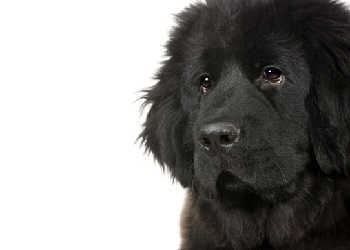 This breed originated in Newfoundland from a dog native to the island called St John’s dog. They are believed to have been interbred with Mastiffs brought to the island by Portuguese fishermen in the 16th century.
This breed originated in Newfoundland from a dog native to the island called St John’s dog. They are believed to have been interbred with Mastiffs brought to the island by Portuguese fishermen in the 16th century.
Both the St John’s dog and the Newfoundland were used as working dogs, hauling fishing nets. The Newfoundland was also strong enough to pull carts. Newfoundlands prospered in England until 1914 and again in 1939 when the breed was almost lost. Since the 1950s it has become popular again in spite of its obsessive love of mud and water, and is an invaluable dog for water rescues.
The Newfoundland is a gentle giant with an endless capacity for loyalty.
Personality
Courage, calmness, docility, stoicism and loyalty mark the nature of this breed. It is easy to train and good with other animals especially when trained early. It is a dog of tremendous size and strength.
One quirky characteristic of the Newfoundland dogs is that they are addicted to rescuing people from the water, even innocent swimmers! They are hard wired to go after their owners in the water and bring them back to safety. Their muscular build, thick double coat, tremendous lung capacity and webbed feet make them excellent swimmers. Newfoundlands love people. They are extremely protective of their family and make a great watchdog. They are also very trustworthy with children although they may be too large and heavy for them. They get along well with other pets, but need consistent human companionship.
Upkeep
Regular, once-a-week grooming is important and ears and feet need trimming. The Newfoundland sheds a lot of hair. Drool can also be a problem with this breed as they have big jowls and droopy lips. Newfoundlands need a very large supply of drinking water.
Newfoundlands require moderate exercise, so a daily walk is sufficient. Swimming is also an excellent way for a Newfoundland to keep fit. Beware that too much exercise at a young age can lead to painful problems later in life. Never exercise a Newfoundland in hot, sunny weather. Like all dogs, Newfoundlands require regular flea, tick, worms and heartworm treatments. Speak to your veterinarian on various treatment options open to you. Desexing and vaccination against diseases, like the parvo virus doggy cough, are also important to discuss with your vet.
Compatibility
Newfoundlands need an active owner who understands their love of water. Their size and weight makes them unsuitable for small children and frail, elderly people. They are definitely not suitable for an apartment or small house. Not a good dog for hot climates, this dog doesn’t do well with humidity and needs a spacious garden, preferably with access to a large swimming area, such as a lake or large pond.
Newfoundlands do not like to be left alone for long periods.
Fact file
Breed classification Utility
Size Giant
Origin Newfoundland
Lifespan 8- 13 years
Colors Black, brown, black and white, and grey (grey not recognized by the Australian National Kennel Council)
Cost $2000 – $2500
Common hereditary problems Hip and elbow dysplasia, bladder stones and heart problems.
